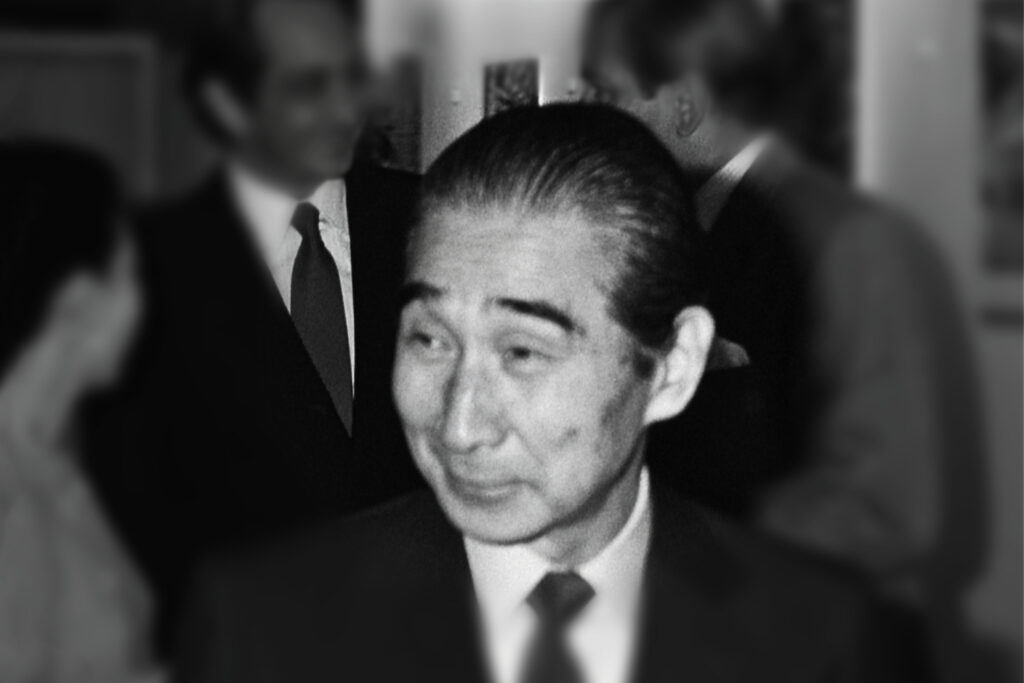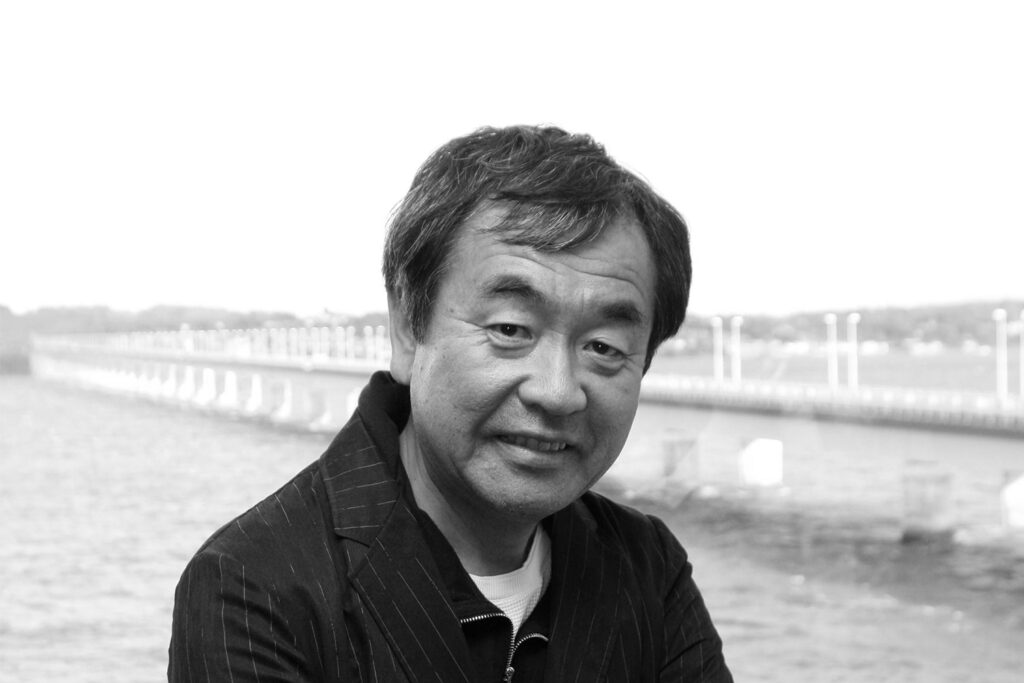This is the first article in Housing Japan’s ‘Japan’s Best Architects Series’
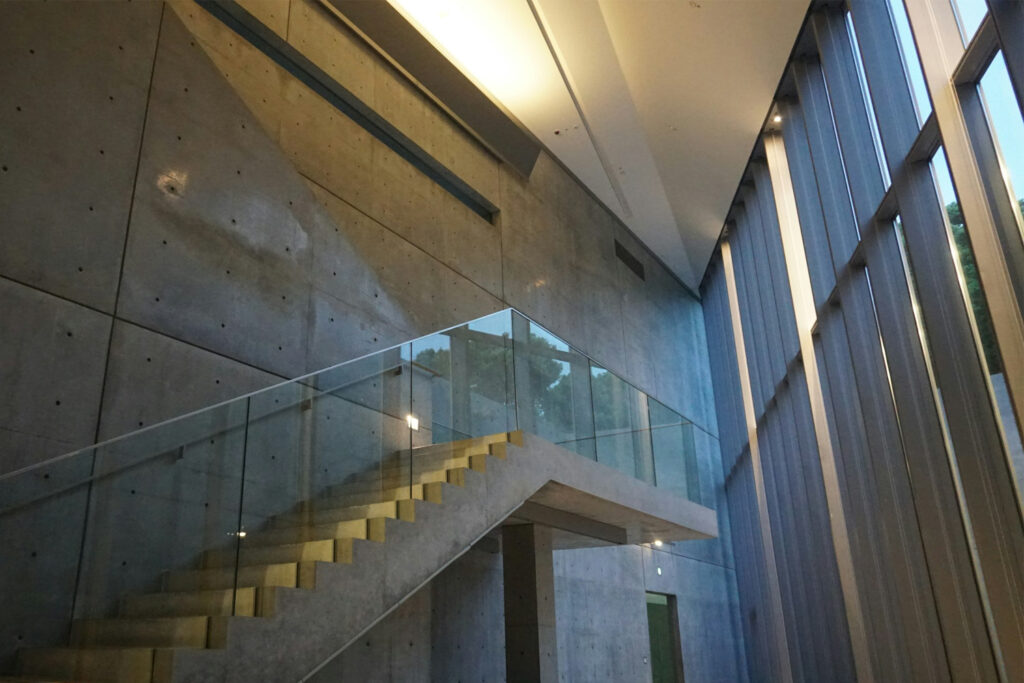
When you walk through Tokyo’s urban landscape, you might notice certain buildings that seem to glow from within. Their smooth concrete walls catch light in ways that feel almost magical, creating moments of calm in the busy city. These are likely the works of Tadao Ando, Japan’s most celebrated architect and a master who has transformed how we think about concrete, light, and space.
Ando’s buildings don’t compete with the urban chaos around them. Instead, they create quiet sanctuaries using the simplest materials, concrete, glass, and steel, arranged to work in harmony with sunlight, wind, and water. His approach has influenced architects worldwide and established him as one of the most important architectural voices of our time.
Who is Tadao Ando?
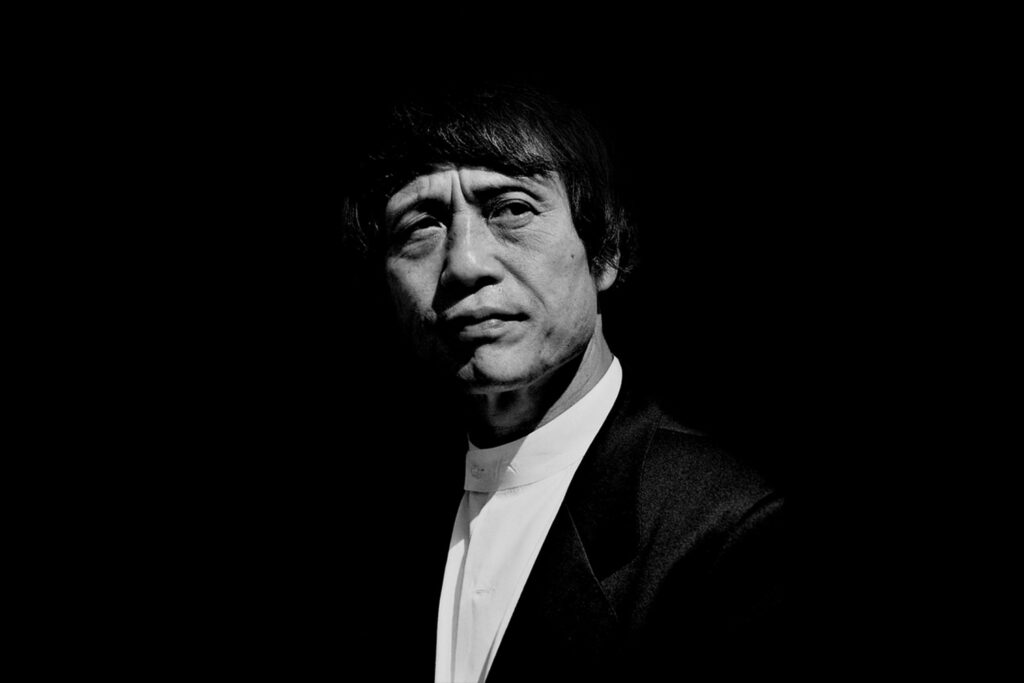
Tadao Ando photo by krss (Flickr), used under CC BY‑SA 2.0. Original image: [flickr: Tadao Ando]
Tadao Ando is not your typical architect. Born in Osaka in 1941, he never went to architecture school. Instead, he taught himself by traveling the world and studying buildings by famous architects like Le Corbusier and Frank Lloyd Wright. Before becoming an architect, he was a professional boxer and truck driver. This unusual background shows in his work, it’s tough and practical, but also surprisingly beautiful.
Ando’s journey to architecture began in the 1960s when he started his own practice in Osaka at age 28. His early projects were mostly small houses in urban Japan, where he developed his signature style of using thick concrete walls to create private, peaceful spaces within busy neighborhoods. These early residential projects, like the famous Azuma House in Osaka (1976), established his reputation for creating dramatic spaces with minimal materials.
His breakthrough came through a series of concrete houses and small religious buildings that showed how modern architecture could capture something spiritual and deeply Japanese. Unlike many architects who worked on large commercial projects, Ando built his reputation one careful, thoughtful building at a time.
Recognition and Global Influence
Ando’s work gained international attention in the 1980s and 1990s as architecture critics recognized his unique approach to combining modern materials with traditional Japanese ideas about space and nature. In 1995, he won the Pritzker Prize, which is considered the highest honor in architecture. When he received this award, he donated the $100,000 prize money to help orphans from the devastating Kobe earthquake that had occurred earlier that year.
The Pritzker Prize opened doors to major international projects. Ando has since designed buildings across the globe, including the Modern Art Museum of Fort Worth in Texas, the Pulitzer Arts Foundation in St. Louis, and renovations of historic buildings like the Palazzo Grassi in Venice, Italy. His international work shows how his Japanese-influenced approach to space and light translates across cultures.
Beyond the Pritzker Prize, Ando has received numerous other honors, including the Royal Gold Medal from the Royal Institute of British Architects (1997) and the AIA Gold Medal from the American Institute of Architects (2002). These awards recognize not just individual buildings, but his overall contribution to how people think about architecture and its relationship to the natural world.
Projects Across Japan and Beyond
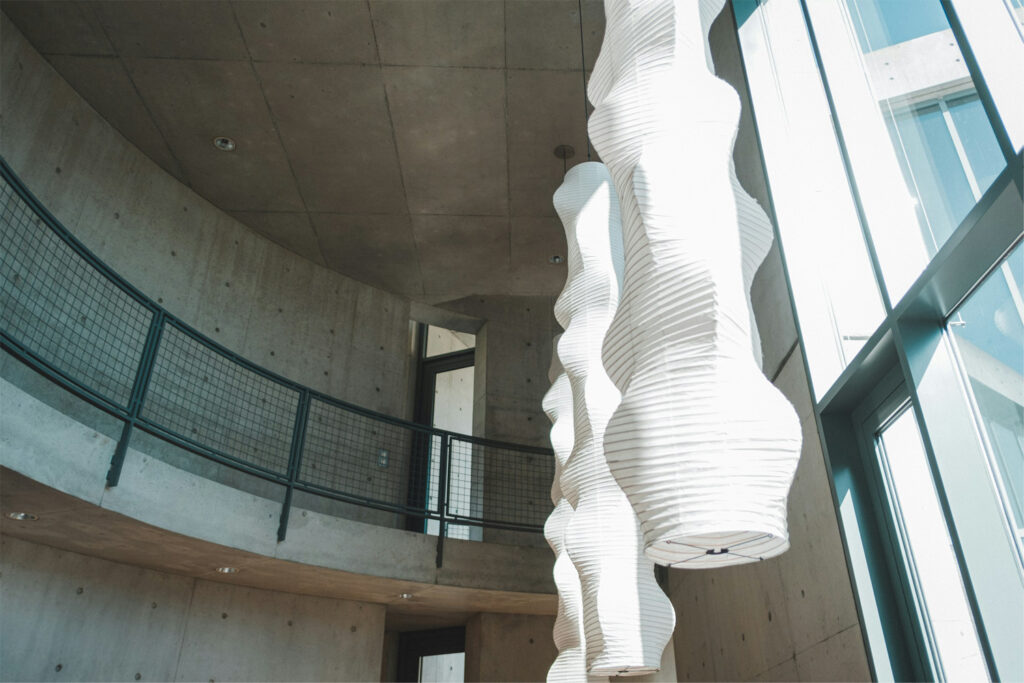
While Tokyo contains some of his most visible work, Ando’s influence extends throughout Japan. His Church of Light in Osaka remains one of his most famous projects, where a simple cross-shaped opening in a concrete wall creates a powerful spiritual experience. On Naoshima Island, his Benesse House complex has helped transform a small island into an international art destination, combining museums, hotels, and outdoor installations.
His Water Temple on Awaji Island demonstrates his ability to integrate architecture completely into landscape, with visitors descending through a reflecting pool to reach an underground meditation hall. These projects show how Ando thinks about buildings not as separate objects, but as parts of larger experiences that connect people to their surroundings.
Internationally, Ando’s work has brought Japanese design principles to global audiences. His buildings in Europe and America maintain his signature use of concrete and light while adapting to different climates and cultural contexts. The Modern Art Museum of Fort Worth, for example, uses his characteristic floating concrete forms but incorporates more glass to work with Texas weather and American expectations for museum spaces.
What makes Ando special is how he uses simple concrete to create buildings that work perfectly with natural light, water, and green spaces. His philosophy emphasizes that architecture should be quiet and let nature take the leading role. This approach has made him popular with people who want spaces that feel peaceful and connected to the natural world, whether in busy Tokyo or other major cities around the world.
Signature Style and Buildings
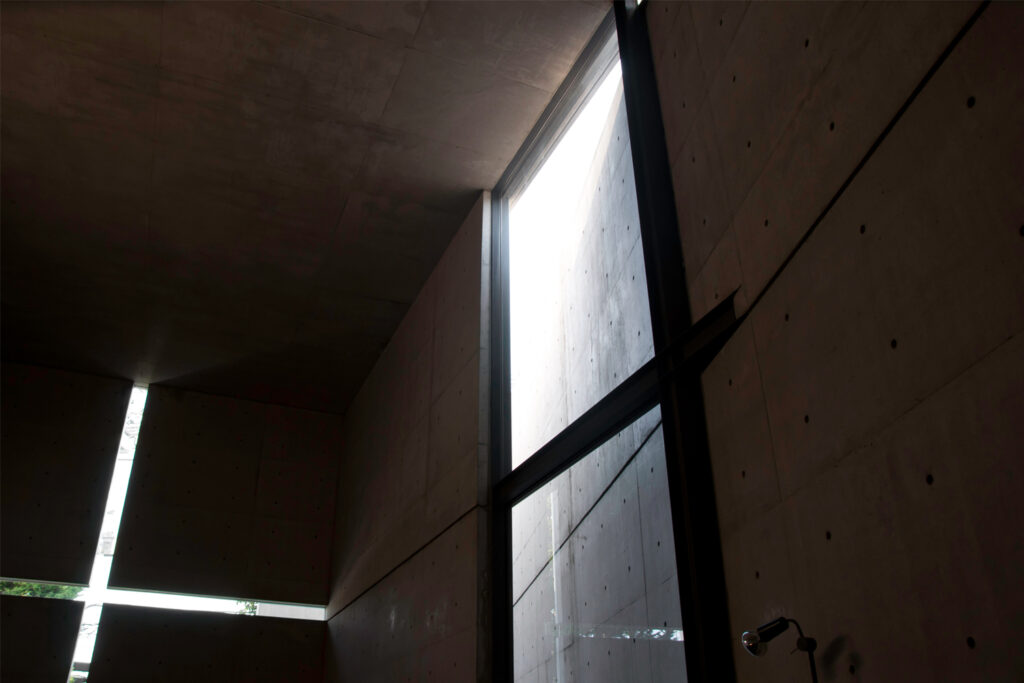
Ando’s style is easy to spot once you know what to look for. He loves using smooth concrete walls, simple geometric shapes, and dramatic lighting. His buildings often include water features, courtyards, and walls with carefully placed openings that frame views of the sky or surrounding landscape.
Some of his most famous Tokyo works include 21_21 Design Sight in Roppongi, where a slanted concrete roof creates underground gallery spaces, and parts of Shibuya Station, where an egg-shaped structure brings natural light into the underground levels. In nearby areas, his Omotesando Hills shopping center features a spiraling ramp that makes shopping feel like walking through a piece of art.
What makes Ando’s concrete special is how smooth and perfect it looks. This isn’t easy to achieve – it requires skilled craftspeople and expensive techniques. The result is concrete that feels warm and elegant rather than cold and industrial. His buildings often feature thick walls with small, carefully placed windows that create dramatic shadows and highlight the changing light throughout the day.
Ando also loves to use water as part of his designs. Many of his buildings include reflecting pools or water features that make the concrete seem to float. This creates a sense of calm and helps connect the building to natural elements, even in busy urban areas.
One of his most celebrated examples outside Tokyo is the Church of Light in Osaka, where he cut a simple cross shape into a concrete wall behind the altar. When sunlight hits this opening, it creates a dramatic cross of light inside the dark interior space. This project perfectly demonstrates his mastery of using minimal materials to create powerful, spiritual experiences that connect people to both architecture and nature.
The Art of Light and Shadow
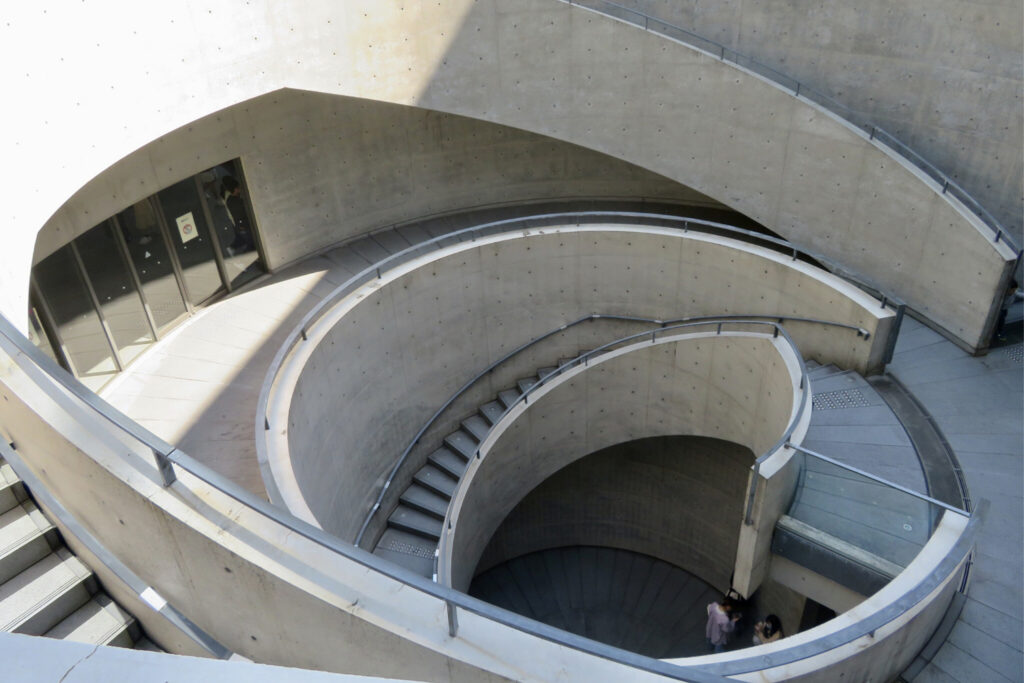
Central to Ando’s approach is his masterful use of natural light. He doesn’t just add windows to his buildings, he choreographs how light moves through spaces throughout the day and across seasons. His concrete walls become canvases for light and shadow, creating ever-changing patterns that make each visit to his buildings feel different.
In his design process, Ando spends enormous attention on how people will move through his spaces. He creates journeys rather than just rooms, leading visitors along carefully planned paths that reveal new views and experiences. Staircases become sculptural elements, corridors frame distant views, and courtyards provide moments of pause and reflection.
This attention to human experience sets Ando apart from architects who focus mainly on how buildings look from the outside. His buildings are designed to be lived in and moved through, not just photographed. The rough texture of his concrete walls invites touch, while the precise geometry of his spaces creates a sense of order and calm.
Notable Projects You Can Experience
Several of Ando’s Tokyo-area works are open to the public, making it easy to experience his architecture firsthand. The 21_21 Design Sight museum in Roppongi hosts rotating exhibitions and allows visitors to walk through his distinctive slanted concrete spaces. The building feels like it’s emerging from the ground, with most of the space underground but filled with natural light.
Omotesando Hills offers a different experience, a spiraling journey through a luxury shopping center that makes moving through the building feel like visiting a museum. The building’s wedge shape responds to the narrow lot it sits on, showing how Ando adapts his style to different sites and functions.
Even Tokyo’s busy Shibuya Station includes Ando’s work, though many people pass through without realizing it. His contributions to the underground spaces show how good architecture can improve daily life for millions of people, bringing moments of beauty and calm to the most functional spaces.
Outside Tokyo, some of Ando’s most powerful buildings reward the journey to see them. The Water Temple on Awaji Island creates one of the world’s most unusual religious experiences, while the Hill of the Buddha in Sapporo shows how architecture can completely transform how we experience sculpture and landscape.
Ando’s Influence on Modern Architecture
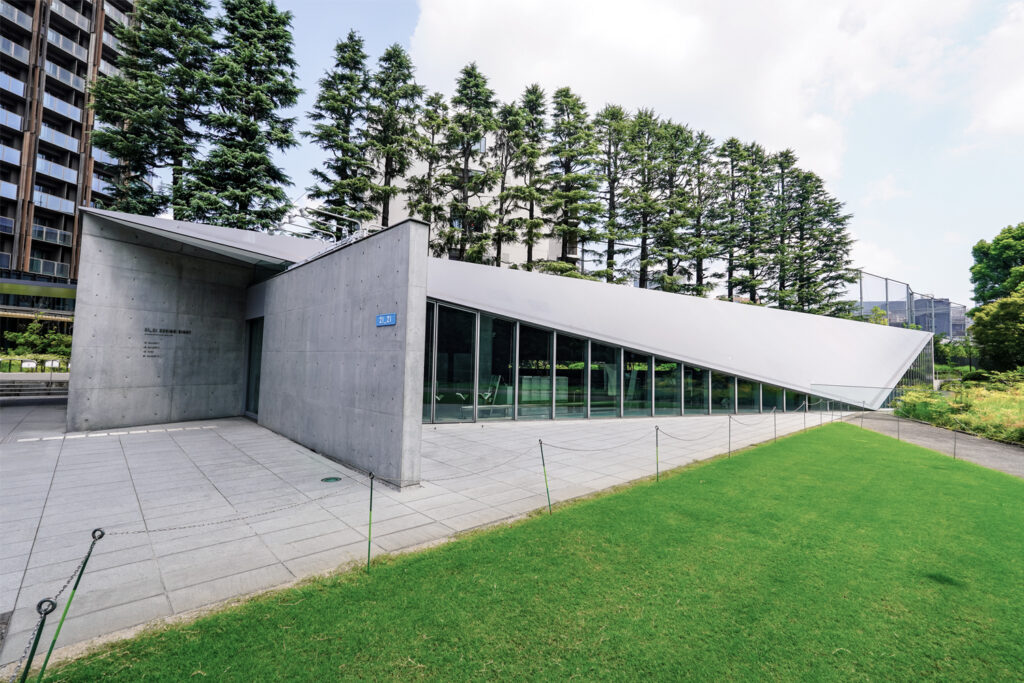
Ando’s impact extends far beyond his own buildings. His approach to using simple materials in sophisticated ways has influenced architects worldwide. His emphasis on the sensory experience of architecture, how buildings feel, smell, and sound, not just how they look, has helped shift architectural thinking toward more human-centered design.
His success as a self-taught architect has also inspired others to pursue architecture through unconventional paths. Ando proves that deep observation, careful study, and genuine passion for the craft can be as valuable as formal training. His background in boxing taught him discipline and focus, qualities that show in every detail of his buildings.
Perhaps most importantly, Ando has shown how modern architecture can honor traditional values without copying traditional forms. His buildings feel deeply Japanese while using completely contemporary materials and techniques. This balance between innovation and cultural continuity has made him a model for architects working in rapidly changing societies around the world.
The Legacy Continues
At over 80 years old, Ando continues to work on major projects and mentor young architects. His recent buildings show continued evolution and experimentation, proving that great architects never stop learning and growing. His influence can be seen in the work of countless younger architects who have learned from his example of combining technical mastery with spiritual depth.
For visitors to Tokyo, experiencing Ando’s architecture offers insight into how thoughtful design can improve daily life. His buildings demonstrate that even the most functional spaces – train stations, shopping centers, museums – can become places of beauty and contemplation when designed with care and vision.
Conclusion: Architecture as Art and Experience
Tadao Ando’s contribution to architecture extends far beyond creating beautiful buildings. He has shown how architecture can touch people’s emotions, connect them to nature, and create moments of peace in busy urban environments. His mastery of concrete, light, and space has established him as one of the most important architects of the modern era.
For those interested in architecture and design, Ando’s work offers lessons in how simplicity and precision can create profound experiences. His buildings prove that the best architecture doesn’t just shelter us, it inspires us, calms us, and reminds us of our connection to the natural world.
Whether you’re traveling around Japan or settling into the vibrant heart of Tokyo, Housing Japan understands the importance of architectural heritage and cultural significance. For those considering luxury real estate in Tokyo, areas with Ando’s work offer a combination of cultural significance, architectural heritage, and daily beauty, though property decisions should always consider multiple factors including location, market conditions, and personal preferences. As Tokyo continues to evolve, the principles Ando represents, quality, simplicity, and harmony with nature, may remain important factors in defining some of the city’s most appealing places to live.
See Tadao Ando’s personal website -> here
Q&A: Common Questions About Tadao Ando and Tokyo Real Estate
What makes Tadao Ando’s architecture special? Ando creates buildings using simple materials like concrete and glass, but arranges them to work beautifully with natural light and surrounding landscapes. His buildings feel calm and timeless rather than flashy or trendy.
Why is Ando considered so important in architecture? He won the Pritzker Prize in 1995 and has influenced architects worldwide with his approach to combining modern materials with traditional Japanese concepts of space and nature. His self-taught background also makes him unique among major architects.
Can I visit Ando’s buildings in Tokyo? Yes, several of his works are open to the public, including 21_21 Design Sight museum in Roppongi and Omotesando Hills shopping center. Parts of Shibuya Station also include his design work.
What is Ando’s most famous building? While he has many celebrated works, the Church of Light in Osaka is often considered his masterpiece for its dramatic use of natural light and spiritual atmosphere.
How did Ando become an architect without formal training? He taught himself by traveling the world to study buildings by master architects, reading extensively about architecture, and starting with small residential projects where he could experiment and learn from experience.

